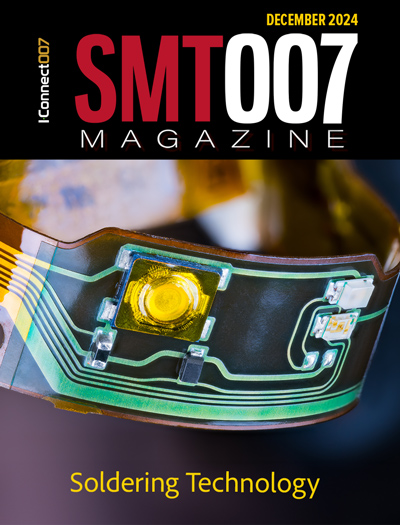-

- News
- Books
Featured Books
- smt007 Magazine
Latest Issues
Current Issue
The Path Ahead
What are you paying the most attention to as we enter 2025? Find out what we learned when we asked that question. Join us as we explore five main themes in the new year.

Soldering Technologies
Soldering is the heartbeat of assembly, and new developments are taking place to match the rest of the innovation in electronics. There are tried-and-true technologies for soldering. But new challenges in packaging, materials, and sustainability may be putting this key step in flux.

The Rise of Data
Analytics is a given in this industry, but the threshold is changing. If you think you're too small to invest in analytics, you may need to reconsider. So how do you do analytics better? What are the new tools, and how do you get started?
- Articles
- Columns
Search Console
- Links
- Media kit
||| MENU - smt007 Magazine
A Tough Coat for Silicon
March 22, 2017 | A*STAREstimated reading time: 2 minutes
A simple, green method that applies a protective coating to semiconductors could help to develop these materials for many applications, from batteries to biosensors.
Silicon forms an oxide layer on its surface when exposed to air or moisture, which can detract from its electronic properties. Adding a ‘skin’ of molecules to the silicon can provide a physical barrier that prevents oxidation, but forming these monolayers can be tricky, requiring an inert atmosphere and long processing times, or demand the use of potentially harmful organic solvents.
Sreenivasa Reddy Puniredd of the A*STAR Institute of Materials Research and Engineering and colleagues have now developed a new way to deliver the protective molecules using supercritical carbon dioxide (scCO2). Carbon dioxide is converted to scCO2 under high pressure, when it becomes a free-flowing liquid that is chemically inert, inexpensive, and more environmentally-friendly than traditional solvents.
The researchers used scCO2 to carry molecules called alkylthiols, which contain long carbon chains with a sulfur atom at one end. Sulfur forms a stable bond with silicon, while the water-repelling carbon chains make a tightly-packed skin on silicon’s surface.
To apply the coating they used alkylthiols containing between seven and 18 carbon atoms to coat silicon, germanium, and silicon nanowires. Each procedure took a few hours, and produced monolayers between 1.6 nanometers and 2.3 nanometers thick that resisted wear and repelled water. The greatest effect was seen for the longest alkylthiol chains.
The monolayers also protected the surface from oxygen for more than 50 days; those prepared using conventional solvents were typically stable for less than seven days. “The increase in stability was expected, but such long-term stability was a surprise,” says Puniredd.
Silicon nanowires are being tested for a range of biological applications, including biosensors and antibacterial surfaces. Although fragile and easily damaged by other monolayer formation methods, the silicon nanowires were undamaged by the scCO2 process, allowing the researchers to test how they interacted with human liver cells. Those protected by the 18-carbon alkylthiol significantly reduced cell growth on the nanowires, compared with unprotected nanowires or a flat silicon surface. This is probably because the cells’ proteins could not latch on to the monolayer’s long carbon chains.
“This scCO2 technology can be adopted for many kinds of inorganic surface modification,” says Puniredd. “The technology is not only scalable, but also enhances the quality and stability of the film. It can potentially replace billions of pounds of organic solvents used every year in thin-film fabrication and cleaning applications.”
Suggested Items
RTX's Raytheon Awarded $333M Contract for SM-6 Block IA Production
01/15/2025 | RTXRaytheon, an business, was awarded a $333 million contract from the U.S. Navy to produce Standard Missile-6 (SM-6) Block IA missiles.
SMT Mounter Market Size Projected to Reach $5.06 Billion by 2030
12/23/2024 | openPRAccording to the new market research report "Global SMT (Surface-mount Technology) Mounter Market Report 2024-2030", published by QYResearch, the global SMT (Surface-mount Technology) Mounter market size is projected to reach USD 5.06 billion by 2030, at a CAGR of 4.7% during the forecast period.
Saab Receives Order from Sweden for Sea Giraffe 1X Naval Radar
12/16/2024 | SaabSaab has received an order from the Swedish Defence Materiel Administration (FMV) for the Sea Giraffe 1X radar system to the Swedish navy. The order value is approximately SEK 340 million with deliveries 2024-2026.
Fresh PCB Concepts: PCB Plating Process Overview
12/12/2024 | Team NCAB -- Column: Fresh PCB ConceptsIn this installment of Fresh PCB Concepts, Mike Marshall takes the helm stating: PCBs have been the platform for the interconnection of electronic components for decades. Because of process costs and other constraints, such as mechanical properties or size limitations of the alternatives, PCBs will remain the standard low-cost interconnection technology. Rapidly increasing performance and functionality requirements of wireless and high-speed devices have challenged the development and implementation of new manufacturing solutions.
Dana on Data: Merging 2D Electrical, 3D Mechanical Worlds
12/04/2024 | Dana Korf -- Column: Dana on DataImagine the day when placing components and routing signal traces and power planes are not constrained by 2D PCB fabrication processes and materials. Astronauts working on the space station have equipment mounted on all axes. They are not constrained by having to stand on a flat surface. They already have a 3D printer at the space station. Why can’t we create PCBs in a 3D space?


